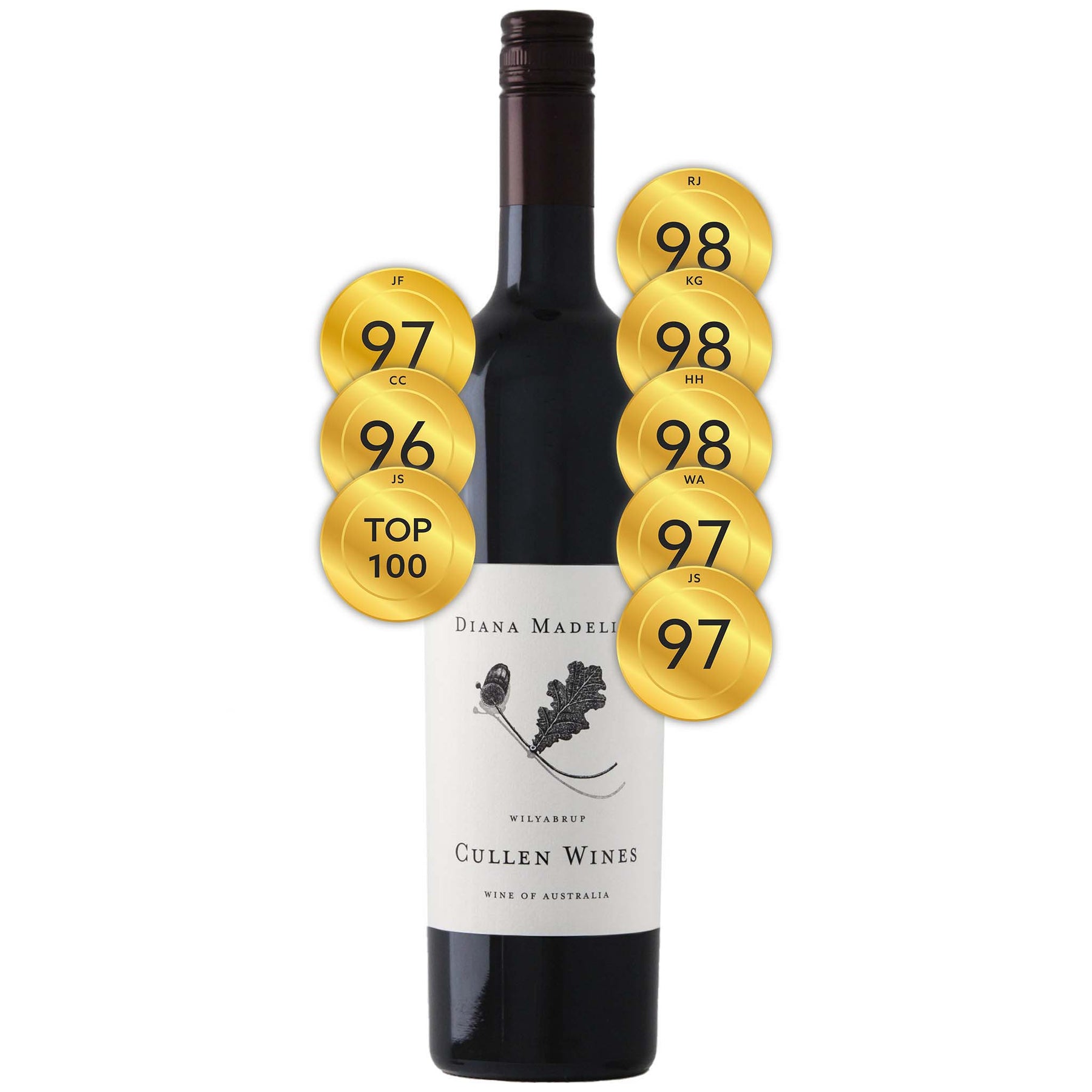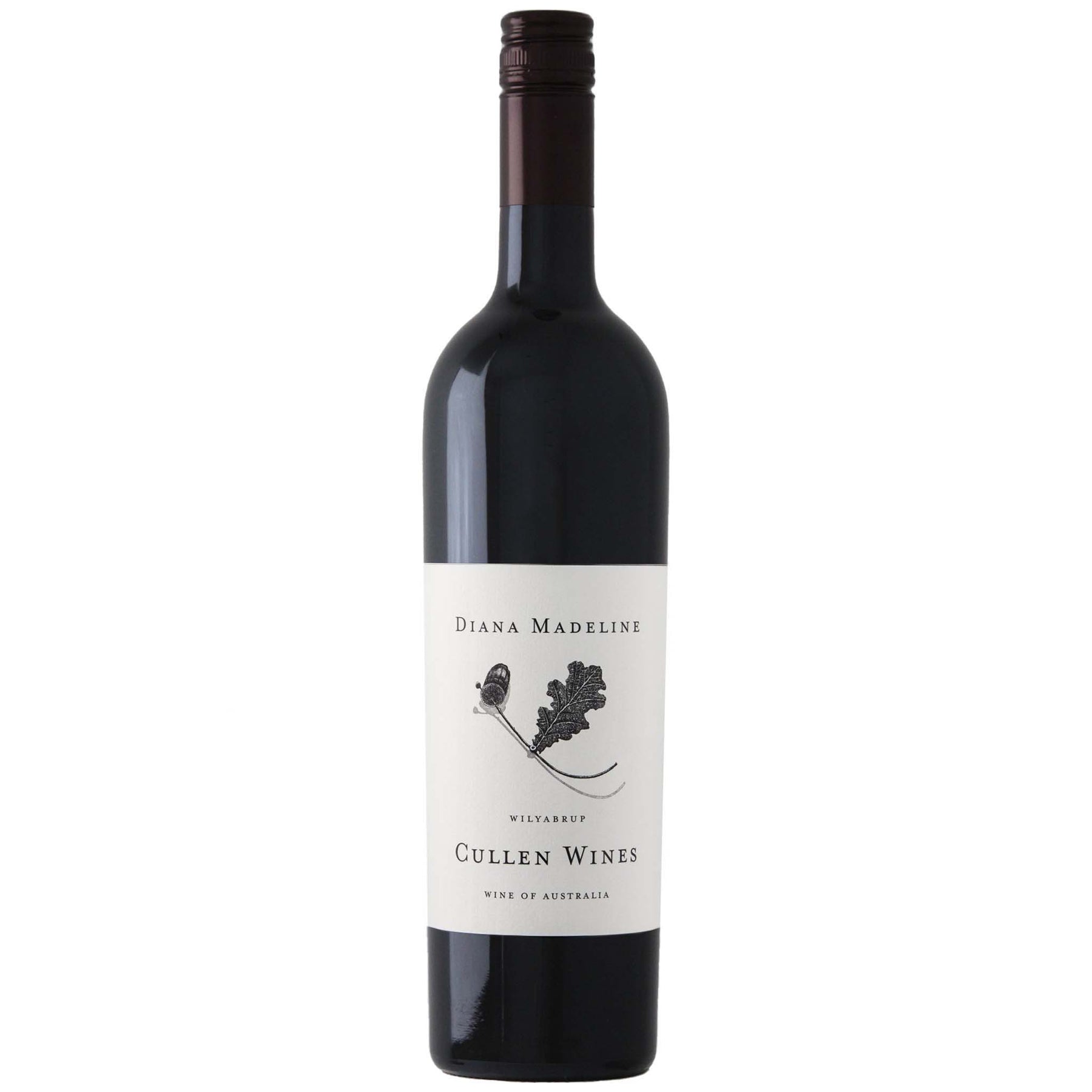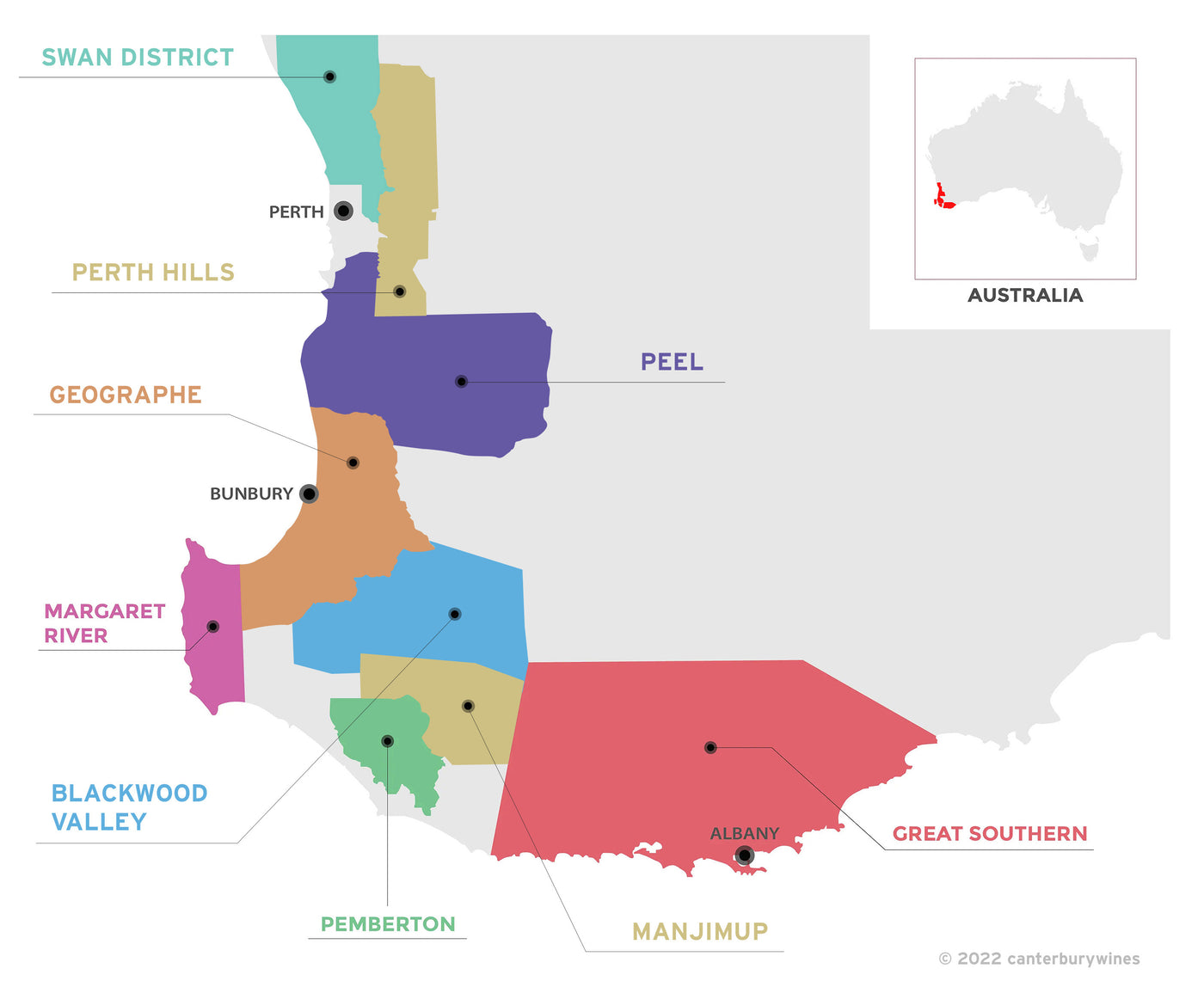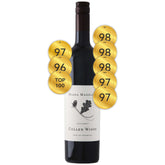

Cullen Diana Madeline 2022
Style: Red Wine
Closure: Screwcap
Cullen Diana Madeline 2022
Camberwell
Burke Road
Camberwell VIC 3124
Australia
Critic Score: 98
Alcohol: 13.5%
Size: 750 ml
Drink by: 2055
James Suckling Top 100 Wines of Australia 2024
Cullen is an iconic Margaret River winery and the Diana Madeline is their flagship red wine. It is famed for its quality and consistency, is sought after by collectors world-wide and is a worthy regional benchmark. It is a classic Cabernet Sauvignon dominant Bordeaux blend grown on an exemplary vineyard. The Cullen vineyard has been certified both Organic and Biodynamic since 2004.
"An Australian icon. The nose is deeply perfumed and elegant with an underlying power, giving aromas of blackcurrants, mulberry bush, tobacco leaves, violets, blueberries and ferric earth. The full-bodied palate has seamless tannins and an incredible array of complex flavors: wild-blackberry compote, graphite, tea leaves, blood plums, dark cherries and mocha. A superb wine that will live for decades to come." James Suckling
"Mulberry, velvet cherry, red brick. On the nose rich cherry, chocolate , rose, violet, ironstone, curry leaf. Juicy rich structure, rich chocolate, mulberry, cherry with beautiful fine grained tannins supporting ethereal fruit with unctuous texture and complexity inviting you back for another taste and glass of this delicious wine. Drinks well now and will last for at least 50 years." Cullen
Expert reviews
"Really delivers as you might expect from this excellent concentrated and powerfully framed vintage in Margaret River. It is dominant Cabernet with smaller portions of Merlot, Cabernet Franc and Malbec. Typical of this wine since switching to biodynamics, it is bright and brilliant with a nervy tense energy to drive the palate. The succulent fruit is harness by fine chalky tannins and neatly played oak of which 55% was new. A wine of extraordinary elegance and poise with a life of many decades. Drink: 2023-2068." Ray Jordan, Wine Pilot – 98 points
"Needless to say, Margaret River enjoyed another superb vintage with the 2022 season. Slightly cooler, Cullen report that it was a vintage of "immense perfume and texture". This wine will be released early February to coincide with Diana’s 101st birthday. The wine is a wonderfully vibrant purple in colour. The nose gives up plums, cassis, spices including nutmeg, chocolate, mocha, bay leaves, cigar box notes – think a freshly opened box of Cohiba Siglo VI – and near perfect oak integration. This is finely balanced and exhibiting immense length on a palate that sees the emergence of aniseed, mulberries and coffee beans. An alluringly supple texture with the silkiest of tannins, though plenty of them – there really is some grip here. This will easily sail through fifteen to twenty years in a good cellar. Drink: 2023-2043." Ken Gargett, Wine Pilot - 98 points
"Deep bright purple-red colour leading into a stylish bouquet of sweet mulberry and other berry fruits, violets and cassis, succulent and mouth-filling, with masses of fine emery-like tannins that run the length of the palate adding authority, structure, length and refreshment to the aftertaste. Concentrated, superripe blackberry, cassis and mulberry flavours; oak tucked discreetly into the background. Drink: 2026–2047." Huon Hooke, The Real Review - 98 points
"An Australian icon. The nose is deeply perfumed and elegant with an underlying power, giving aromas of blackcurrants, mulberry bush, tobacco leaves, violets, blueberries and ferric earth. The full-bodied palate has seamless tannins and an incredible array of complex flavors: wild-blackberry compote, graphite, tea leaves, blood plums, dark cherries and mocha. A superb wine that will live for decades to come. Made from 89% cabernet sauvignon, 5% merlot, 3% cabernet franc and 3% malbec, farmed biodynamically. Drink or hold. Screw cap." James Suckling, JamesSuckling.com - 97 points and Top 100 Wines of Australia 2024
"The 2022 Diana Madeline is a blend of 89% Cabernet Sauvignon, 5% Merlot, 3% Cabernet Franc and 3% Malbec that matured for 14 months in 55% new French oak. 2022 was a warm but superb vintage in Margaret River, and the reds (particularly the reds) are ripe, fleshy, succulent and svelte. This 2022 Diana Madeline leads with pomegranate and raspberry, salted licorice, bay leaf and saltbush, and it even smells svelte. Superb. In the mouth, the wine has all the black tea, graphite, coal dust, cacao and nori that we have come to love and expect from this wine. I love the way it feels in my mouth, and I love the draw of flavor across the palate. No doubt this vintage will ignite the usual "I prefer cool vintages/I prefer warm" debate; however, I am on record many times expressing my favoritism for vintages like 2018 over 2019, despite them both being equally excellent wines. You go your own way; it's merely a matter of preference. Drink: 2023 - 2038." Erin Larkin, Wine Advocate - 97 points
"The best wines are distinctive with a clear DNA link to place. Diana Madeline is one such wine. An excellent deep purple hue with an ever-changing array of aromas: one minute spice, mulberries and cocoa when first poured, and next full of savoury notes of black olive tapenade, nori and menthol. As usual, it’s beautifully framed yet the fuller-bodied palate is plumped up by textural, expansive tannins and finishes long. Get a spot ready in the cellar, this has time on its side. Drink by 2045." Jane Faulkner, Halliday Wine Companion - 97 points
"A glass of Diana Madeline is always a pleasure; this vintage is no exception. 89% Cab Sav, 5% Merlot, 3% Cab Franc, 3% Malbec; biodynamic and hand-harvested over five picking dates. 14 months in 55% new French oak. Still in its youth, however, it is already delivering waves of delicate black fruits, just-ripe raspberry, nori, white pepper, crushed black cardamon, soft liquorice, and fresh and pretty florals of native violet and lilac. There’s a distinctive salinity reminiscent of salt-crusted rocks down the road on the Indian Ocean coastline. Oak is clearly present here, and its quality is unquestionable as it frames the fruit and will continue to develop in cohesion. The palate is velvety with slinky yet firm and polished tannins. The finish is long and delivered in waves of flavour, whilst interest is held long after the wine has left the mouth. The palate is a burst of flavour, natural fruit sweetness and generosity, delivered aplomb with restraint and verve. Crystalline fruit shows an expression of place and its people. Be certain to decant this, especially if drinking now. Drink: 2024-2044." Cassandra Charlick, Wine Pilot - 96 points
Awards
James Suckling Top 100 Wines of Australia 2024
Organic/biodynamic

The combination of firstly organic, and subsequently biodynamic viticulture at Cullen Wines provides the opportunity for the land to exist at its full potential, thereby nurturing vines to produce their best and most individual grapes. Vanya Cullen has pushed the limits of biodynamic practices in every facet of the business and the yield of the estate vineyards has soared. All Cullen Wines are grown on a certified Biodynamic, Carbon Neutral and naturally powered estate.
Organic Viticulture
Since 1971 when the Cullen Vineyard was planted, chemical intervention was minimal and the family's concern for the environment paramount. In 1998 the change to total organic viticulture was made. Organics is about soil health and Diana and Vanya went intuitively towards healing the soil by putting back what had been taken out. Organic farming promotes biological activity, which converts plant and animal residue into stable humus. This in turn increases the soil's ability to retain moisture and provide a reserve of nutrients. The Cullen vineyards were certified A Grade Organic in 2003.
Biodynamic Viticulture
In 2003, whilst attending a Biodynamic Conference, Vanya Cullen decided that Biodynamics would add further to the holistic and natural approach to both vineyard and winemaking. Biodynamics builds on organic farming to make all organic processes work more efficiently and effectively.
Biodynamic viticulture is a philosophy combining the maintenance of sustainable soil fertility and the recognition of the link between plant growth and the rhythms of the cosmos. Moon rhythms strongly influence life on earth life. As tides rise and fall in a pulsing rhythm, so does the sap of plants and all other liquids including those within the earth's mantle. Viticultural practices are conducted according to these moon rhythms. The position of the moon in relation to the planets is critical in determining the optimal time to plant.
In addition, the difference between organic and biodynamic is the use of biodynamic preparations 500 and 501, with 502-508 also being used. Preparation 500 is cow horns filled with cow manure which helps the soil develop humus and attracts earthworms and micro organisms. Preparation 501 is cow horns filled with quartz crystals which aids photosynthesis and the uptake of minerals in the soil.
In 2004 the Cullen vineyards were certified A Grade Biodynamic.
About the winery

In 1948, Dr Kevin John Cullen and his wife Diana Madeline Cullen purchased their property in Wilyabrup, which is in the heart of Margaret River. In early 1965 they started considering other uses for their sheep and cattle farm. They decided to plant lupins, so invited Dr John Gladstones (who had studied lupins in his post-graduate research) to visit their property. Dr Gladstones had also put considerable work and research into the suitability of growing vines in southwestern Australia and, according to Diana, upon seeing their land said "Oh, you're mad growing cattle and sheep, why don't you grow grapes?"
Dr Gladstones described Wilyabrup as being the sweet spot of the Margaret River region, most favourable for growing Cabernet Sauvignon. In 1966 he published his now-famous report which compared the climate and soils of Margaret River to that of Bordeaux. Many regard him as the founder of the Margaret River wine region.
In 1971 Kevin and Diana Cullen made the decision to plant 18 acres of vines on the land, including their first Cabernet Sauvignon vines. Further plantings were made over the subsequent decades. The mature 28-hectare dry grown vineyard still operates today and the grapes for all the Cullen wines are sourced from here and the adjacent Mangan Vineyard which was planted in 1995.
While Kevin Cullen worked as a doctor to support the business, Diana Cullen supervised and managed the winery and became Chief Winemaker in 1981. Diana made history in 1982 by being the first woman to win a trophy at the Perth Royal Show. Kevin passed away in 1994 and Diana in 2003, and the Cullen flagship wines are now named in their honour; the Kevin John Chardonnay and Diana Madeline Cabernet Sauvignon Merlot. Both Kevin and Diana have been awarded life membership with the Margaret River Wine Industry Association, and in 2003 the WA Wine Industry Association introduced the annual Diana Madeline Cullen Award for Outstanding Contribution by an Individual to the WA Wine Industry in her honour.
In 1983 Diana was joined by daughter Vanya Cullen, who took over the reign as Chief Winemaker in 1989 and was also appointed Managing Director in 1999. With Vanya at the helm, the quality of the wine is paramount and every step taken in the vineyard and in the winemaking is geared to that aim. The quality of Cullen Wines comes in the main from the vineyard - the wines can only be as good as the grapes. To realise the full potential of the vineyard, Vanya has embraced organic and biodynamic viticultural practices and the vineyards were certified A Grade Organic in 2003 and A Grade Biodynamic in 2004.
The process of making the wine involves handling the fruit as little and as gently as possible. Practices such as hand harvesting, minimal fruit transport, sorting of the fruit before crushing, minimal wine movement, minimal fining for the whites, no fining for the reds and minimal filtration are employed. The wines mostly make themselves, with little or no intervention; which means the use of indigenous yeast, no additions of any kind and minimal oak use and fining.
Vanya Cullen received the "Australian Winemaker of the Year" award from Gourmet Traveller Wine magazine in 2000 and was voted "Woman of the Year" by UK based wine magazine The Drinks Business in 2008, becoming the first Australian to receive the award. Vanya was also awarded Halliday Wine Companion's winemaker of the year in 2020.
Cullen became the first vineyard and winery in Australia to be certified carbon positive, starting the process in 2006. Vanya Cullen is also on the board of the "Days of Change" program, which aims to help Western Australian people and businesses live and operate in a more sustainable way.
2021 marked a half-century for the brand and with it a celebration of the Cullen Wines legacy. "This year we celebrate 50 years of Cullen Wines – 50 years of sustainable wine growing preceded by 65,000 years of Wadandi sustainable land care," says Vanya. "Over that time we've been supported by generous people with a wonderful spirit of camaraderie and warmth of spirit, and we are so grateful."


Western Australia
Western Australia is home to more than 400 wineries across nine vast and extraordinary wine regions which are almost entirely concentrated in the south-west and great southern land divisions of the State. The regions are Blackwood Valley, Geographe, Great Southern, Peel, Pemberton, Manjimup, Margaret River and Swan District.
The oldest region is the Swan Valley, the best known both nationally and internationally is Margaret River and the largest is Great Southern. The Great Southern region is further divided into the five subregions of Albany, Denmark, Frankland River, Mount Barker and Porongurup.
The history of wine production in Western Australia dates back to 1840 with the establishment of Sandalford in the Swan Valley region. The recognition of the fine wine possibilities started to be realised after the establishment of the Margaret River Region in 1967, which has become renowned for its high quality Chardonnay and Cabernet Sauvignon. The other regions produce a diverse range of regionally distinct wines, from stunning Rieslings and evocative Shiraz, to a range of unique Cabernet Sauvignon blends.



